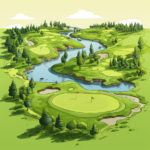Although it is often overlooked, the type of grass a golf course uses can have a significant impact on the game. Each type of grass plays a unique role in the game and requires specific maintenance, which varies based on factors such as climate, cost, and durability.
While there are dozens of types of grass used on both the fairways and greens, some of the most popular choices in the United States include Bermuda, Bentgrass, and Zoysia. One of the most important jobs of a golf course is to pick a type of grass that will flourish based on the local climate, soil conditions, and traffic the course will have. If a course makes the wrong grass choice, it can significantly worsen the play.
Key Takeaways
- Golf courses in the United States use dozens of types of grass for optimal playability and course maintenance.
- The most popular grass choices in the United States include Bermuda, Buffalo, Bentgrass, and Zoysia.
- Selecting the right grass is crucial for the local climate, soil conditions, and intended playability.
1. Bermuda Grass
Bermuda grass is a warm-season turf and is highly valued for its remarkable heat and drought tolerance, which makes it an ideal choice for golf courses in regions with warmer climates (as well as most courses during the peak of summer).
Not only is Bermuda grass capable of enduring scorching temperatures, but it is also one of the quickest-growing grasses, which makes it ideal for high-traffic courses. This quality is essential for golf courses that endure heavy foot traffic and frequent divots. From a player’s perspective, the fine texture and high density of Bermuda grass allows the ball to carry and is easy to walk on.
There are dozens of strains of Bermuda grass and one of the most popular is Celebration. Celebration Bermuda grass is known for its robust nature and high tolerance for significant foot traffic. This particular type thrives in warm climates and is well-suited to a variety of soil types, making it an easy selection for most regions in the United States during the summer months. Its vibrant dark blue-green hue contributes to the stunning appearance of the course, which is also a crucial factor in selecting suitable grass.
2. Buffalo Grass
Buffalo grass is also a popular warm-season golf grass that is native to the Great Plains and is well-adapted to the arid climate of the central United States.
In terms of golf course placement, buffalo grass is generally used for fairways, teeing grounds, and roughs. This is because buffalo grass requires minimal maintenance and water compared to many other grass species. Although not typically used for putting greens due to its slower vertical growth and thinner turf, buffalo grass makes a great fairway for low precipitation areas.
Because of its adaptability to drought prone environments, Buffalo grass primarily thrives in the central and southwestern regions of the U.S., where long, dry summers are common. Its adaptability and hardiness make it a sustainable and cost-effective choice for golf course maintenance in these regions.
3. Bentgrass
Bentgrass is a fine-textured perennial grass, often used for putting greens and fairways. Of the various types of bentgrasses, creeping bentgrass is the most popular strain on golf courses due to its ability to thrive in close-mown conditions.
This grass is native to cool and temperate climates, making it one of the preferred choices in the northern regions of the United States. Bentgrass favors areas with ample sunlight, and it’s known for its exceptional ability to withstand cold temperatures and maintain its appealing aesthetics. Because of this many courses will use Bentgrass in the early spring or fall months after peak temperatures have fallen.
Creeping bentgrass is sought out by many golfers as it provides a smooth, dense and uniform playing surface. This is particularly important for the greens, as it ensures consistent ball roll, allowing golfers to focus on their putting accuracy. However, its use on fairways is also desirable due to the grass’s ability to tolerate heavy foot traffic and recover quickly from divots.
While bentgrass is popular and provides an excellent playing surface, it does require a significant amount of maintenance. Regular mowing, fertilization, and irrigation are essential to keep bentgrass healthy and looking its best. Because of this Bentgrass is frequently found on private and high end public courses, and is less common cheap public golf courses.
4. Zoysia
Zoysia grass is a soft, warm-season turfgrass that thrives in the southern regions of the United States. This grass is known for its dense, carpet-like growth, making it an excellent choice for golf courses.
Zoysia grass is among golf course superintendents’ top choices because it is drought-resistant and wear-resistant. It can withstand the scorching sun and still maintain its playable condition. Moreover, since Zoysia is naturally resistant to many turf diseases and pests, and relatively low maintenance compared more premium types of course grass like Bentgrass, making it cost-effective for most courses.
Where we see Zoysia excel is in fairways and tees. Its durability and lush appearance make it ideal for areas that experience heavy foot traffic and club impact. Golfers appreciate Zoysia’s cushiony feel beneath their feet, and that it provides a clean, crisp playing surface. However, Zoysia can sometimes be too dense for putting greens, causing slower ball roll. Therefore, it’s less common on greens compared to other grasses like bentgrass or Bermuda.
From a popularity standpoint, Zoysia grass is especially common across the Southeast and transition regions of the U.S. Because it thrives in humid, subtropical climates, courses in states like Georgia, South Carolina, and Texas often plant Zoysia for their fairways and tees. With its outstanding resilience and overall playability, Zoysia grass has undoubtedly earned its place among golf courses in the warmer regions of the United States.
5. Poa Annua
Poa Annua (annual bluegrass) is a durable grass species found on golf courses throughout the United States. It is known for its ability to thrive in a variety of climates, making it a versatile option for both fairways and greens. Many golf courses use Poa Annua because it can last multiple seasons throughout the year.
In our experience, Poa Annua is particularly well-suited for golf courses located in cool, temperate regions. It can handle a wide range of temperatures and remains green throughout the changing seasons. Because of its versatility, we often encounter it on golf courses across the Pacific Northwest, the Midwest, and the Northeastern United States.
Poa Annua’s fine texture and dense growth make for a smooth and consistent playing surface on the greens. Moreover, its durability helps it withstand the heavy foot traffic and repeated ball strikes common on golf courses.
On fairways, Poa annua also proves to be a reliable choice. It’s ability to grow quickly allows it to outcompete other grass species, providing a lush and even turf. This makes for a more enjoyable playing experience and contributes to the course’s overall appearance.
6. Rye
Ryegrass varieties like perennial ryegrass and annual ryegrass are top choices for many golf course superintendents to use in tee boxes and other high-traffic areas.
Perennial Ryegrass is one of the most commonly used grasses on golf courses due to its durability and fast germination. It is often found in cooler climates, as it can withstand colder temperatures and wetter conditions (making it a great choice for states like Washington and Oregon). The fine texture and dark green color provide an aesthetically pleasing surface, perfect for golf play. It can be used on tees, fairways, and roughs, making it a preferred option for courses to use in high-traffic areas of their course.
Perennial ryegrass is also resistant to diseases and pests, so it requires less maintenance and can withstand players’ constant wear and tear. Additionally, Ryegrass regenerates quickly, so if it is torn up or damaged by frequent playing it can be fixed fairly quickly.
Annual Ryegrass, on the other hand, is a popular “temporary solution” for golf courses transitioning mid-season. Ryegrass germinates quickly, so it can fill in any bare spots or areas that need a quick fix without tearing up the entire hole. This grass variety works well as an overseeding option in warmer-season grasses during the cooler months, providing a green and dense cover for golf courses.
Annual ryegrass is a budget-friendly choice, as it requires less water and fertilizer compared to other grasses. However, its shallow root system makes it not as ideal for long-term use, especially in areas prone to erosion.
7. Fescue
Fescue is a popular grass choice due to its hardy nature and adaptability, particularly in cooler climates. For golf courses, Fine fescue is the preferred choice of most courses looking for an easily maintained grass.
In addition to fine fescue, golf courses may also utilize other types of fescue, such as tall fescue. Tall fescue is a fitting choice for rough areas and fairways as it has excellent tolerance for heat, drought, and wear. It’s known for its deep root system that can extend several feet into the ground, allowing the grass to stay healthy despite challenging course conditions.
There are several additional sub-species of fine fescue, which can be used for different climates and soil conditions including:
- Creeping red fescue
- Chewings fescue
- Slender creeping red fescue
- Sheep fescue
- Hard fescue
These fine fescue grasses offer various advantages to a golf course:
- They tolerate shade and drought quite well, meaning they can thrive in areas where other grasses might struggle.
- Fine fescue has a dense, fine texture that creates a smooth and firm playing surface, perfect for putting greens.
- The deep rooting system of fine fescue helps reduce soil erosion and provides good wear resistance.
- Fine fescue requires less input in terms of water, fertilizers, and pesticides, making it an environmentally friendly choice.
For courses in cooler climates that prioritize environmental sustainability, fescue stands out as a popular choice, especially in the northwest regions.
8. Kentucky Bluegrass
Kentucky Bluegrass is another popular grass choice for northern courses due to its fine-textured, high-quality turfgrass, which creates a smooth playing surface for courses that prioritize regular course maintenance.
Kentucky Bluegrass is known for its deep green color, dense growth, and durability during peak golf season. It thrives in cool-season climates, making it a popular choice for golf courses in the Northern United States and Canada. It can also tolerate a variety of soil types, allowing it to adapt to different courses’ conditions.
Some of the advantages of using Kentucky Bluegrass on golf courses include:
- Disease resistance: This grass species is known for its strong natural resistance to diseases, including fungal infections that can damage the grass.
- Drought tolerance: During periods of low rainfall, Kentucky Bluegrass can slow its growth and go dormant to conserve water, allowing it to survive in droughts and extended periods of heat.
- Cold tolerance: Its ability to thrive in cooler climates means that it can withstand frost and even snowy conditions, allowing the golf course to remain in good condition even during colder months.
- Wear tolerance: As any golfer knows, a golf course sees a lot of foot traffic and wear, especially on tees and fairways. Kentucky Bluegrass has a rapid recovery rate from heavy foot traffic and cart usage, making it an excellent choice for these high-traffic areas.
Despite its many advantages, Kentucky Bluegrass isn’t perfect. It requires regular maintenance, including frequent mowing, fertilizing, and irrigation to maintain its appearance and playability. It can also be susceptible to several pests, including billbugs and white grubs, which may require additional measures to control.
Other Grass Types
Bahia grass and St. Augustine grass are other popular grass types used in select regions of the U.S. and abroad.
Bahia grass is a tough, low-maintenance option often found in the rough or on fairways of golf courses in tropical and subtropical climates (very popular in Hawaii during the summer). Its deep roots make it drought-tolerant and resistant to wear and tear, which makes it ideal for courses with heavy cart usage. Additionally, the coarse texture of Bahia grass slows the ball down as its rolling, making it more frequent on pro-level type courses.
Conversely, St. Augustine grass is a thick, lush, dark green turf that is widely popular in the southern United States (specifically Georgia, Kentucky, and Alabama). This grass type thrives in humid, coastal environments where it can benefit from abundant moisture and sunlight. . However, it is not as wear-resistant as Bahia grass, which means it requires careful maintenance to keep it in proper condition.
It’s not uncommon to find multiple combinations of grass varieties within different areas of the course, such as using Bermuda grass on greens and Bahia grass in the rough. This approach allows courses to maximize the strengths of each grass type while addressing any potential limitations. In the end, the choice of grass plays a significant role in the playability and challenge of the course, making it an essential consideration for golf course design and maintenance.
Criteria for Choosing Golf Course Grass
Grass Maintenance and Course Conditions
When selecting the ideal grass for a golf course, it’s essential for us to consider maintenance requirements and course conditions. Often times the “best” grass requires excessive amounts of maintenance, which is why you will only see it at “premier clubs” and championship courses.
We have to strike a balance between durability, strength, and texture, as these factors directly affect players’ experience. The grass should be able to withstand heavy foot traffic and golf cart movement while maintaining the desired aesthetics and playability. To achieve this, we usually opt for varieties that possess drought resistance and robust growth patterns.
Does Climate Impact Grass Selection?
Yes, climate (temperature, sunlight, precipitation levels) plays a significant role in determining the appropriate grass type for a golf course. Different grass species thrive in different climatic conditions, and it’s crucial to match the grass with the course’s location and weather patterns. For instance, in regions with long, cold winters and short summers, we prefer cool-season grasses, while warm-season grasses are better suited for hot and humid areas.
Understanding Warm-Season and Cool-Season Grasses
Warm-season grasses, such as Bermuda and Zoysia, are ideal for golf courses in southern climates, where they adapt well to heat and humidity. These grasses go dormant during colder months and may require overseeding to maintain visual appeal. For northern golf courses, we often use cool-season grasses like Kentucky Bluegrass, Bentgrass, or Fescue. These varieties can endure cold temperatures and maintain their green color throughout the year.
| Warm-Season Grasses | Cool-Season Grasses |
|---|---|
| Bermuda | Kentucky Bluegrass |
| Zoysia | Bentgrass |
| Buffalo Grass | Fine Fescue |
Do Golf Courses Need Different Grass Types For Specific Course Sections?
Because different areas of golf courses have different levels of foot and cart traffic, they typically require different types of grass. For example, the tee box needs durable grass because every single player will walk on it and shove a tee into the grass. Fairways, on the other hand, do not need to be as durable because they are so spread out.
Below we have included some grass types frequently used in different areas of a golf course:
- Tees and fairways: Bermuda and Zoysia grass, known for their traffic resistance and strength, are top choices for tees and fairways in warm-season climates. In areas with a cooler climate, we tend to use Perennial Ryegrass for its durability and fine texture.
- Greens: Bentgrass is a top choice for putting greens because of its smooth, carpet-like texture. Although its traditionally used for cool-season environments, new strains have been produced to allow use in certain warm-season climates.
Frequently Asked Questions About Golf Course Grass
Fescue and Bentgrass are the nicest golf course grass options for aesthetics and playability when they are well maintained in our opinion. The combination of these grasses creates a beautiful, lush appearance that is also functional for golfers. Fine fescues have fine leaf texture, while bentgrass provides a smooth, even playing surface. Together, they create an exceptional playing experience.
The most cost effective grasses for putting greens are generally creeping bentgrass (Agrostis stolonifera) and Bermuda grass (Cynodon dactylon). Creeping bentgrass is preferred for its fine texture, dense growth, and ability to be maintained at very low mowing heights, resulting in a smooth, fast surface. Bermuda grass is popular in warmer climates, as it tolerates heat and requires less water. Both grasses have excellent wear tolerance and can withstand heavy foot traffic.
Kentucky bluegrass, Bermuda grass, and perennial ryegrass are the most common types of grass used for golf fairways in the United States. Kentucky bluegrass is popular in cooler climates because of its hardiness and impressive appearance. Bermuda grass thrives in warmer climates, has excellent drought tolerance, and can withstand heavy foot traffic. Perennial ryegrass is another great choice for fairways, as it establishes rapidly and provides a consistent playing surface.
Kikuyu grass (Pennisetum clandestinum) is suitable for golf courses, particularly in warmer climates, due to its resistance to heat, drought, and wear. It has a rapid growth rate, allowing it to recover quickly from damage and maintain a consistent playing surface. Additionally, Kikuyu grass can be closely mowed, which facilitates ball travel and creates a more enjoyable golfing experience.
The choice of grass for golf courses varies between countries primarily due to local climate and soil conditions. In cooler regions, such as those found in Northern Europe or North America, golf courses often use cool-season grasses like Kentucky bluegrass, fine fescue, or creeping bentgrass. On the other hand, golf courses in warmer regions like the southern United States or parts of Australia typically opt for warm-season grasses, such as Bermuda grass or Kikuyu grass, as they require less water and are more heat-tolerant. Ultimately, the goal is to choose a grass that thrives in the local environment while providing an exceptional golfing experience for players.







